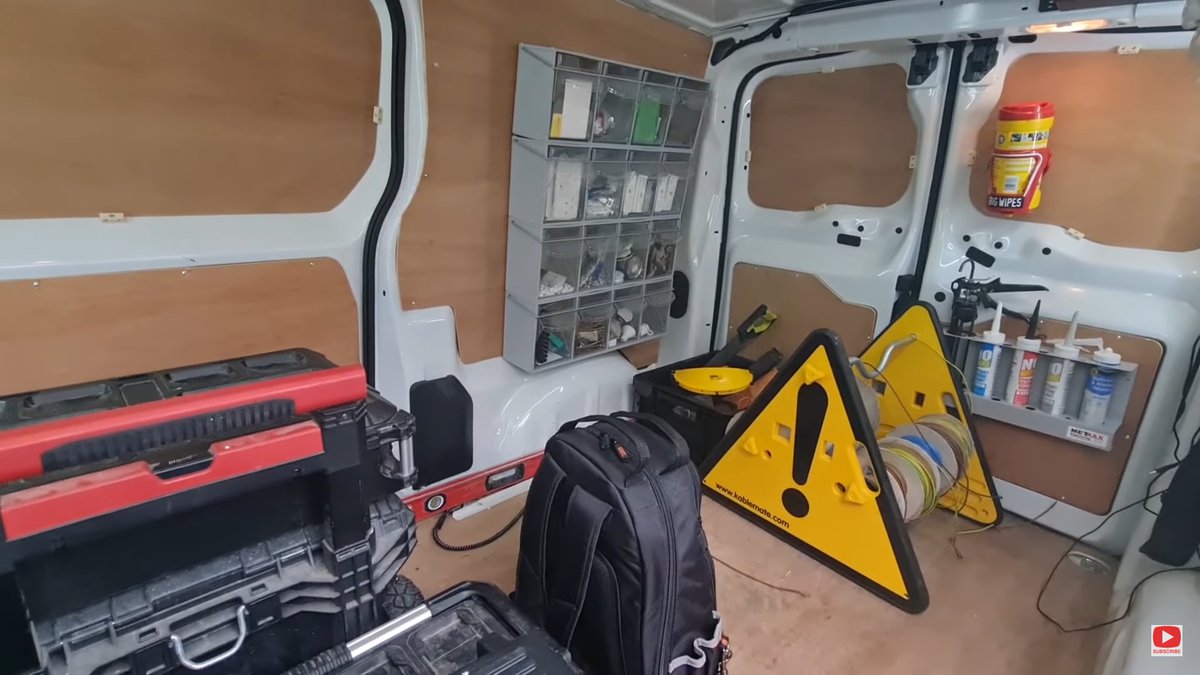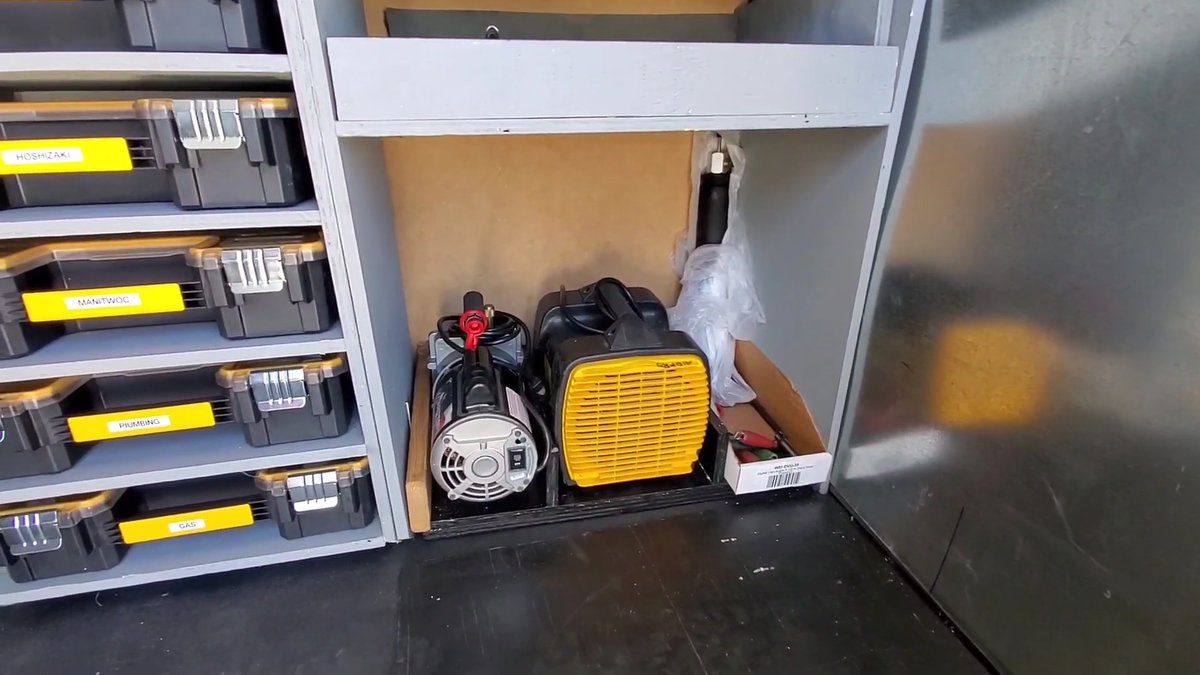Work Van Plywood Walls: Should You Skin It?
July 20, 2021

If you plan to build plywood shelves in your work van, one thing you'll consider is whether you should skin the van's walls with plywood, what plywood you should use, and how you should do it.
Plywood walls are frequently used in tool trailer builds, but this is a no-brainer! Enclosed trailers usually come with plywood walls from the factory. But many tradespeople want to adapt tool trailer build styles to their van.
Let's take a quick look at plywood walls in a van.
Generally, full 1/2" or 3/4" thick plywood walls should probably be avoided on a work van. Weight is one of the largest penalties of full plywood skins and weight will tend to go up over time as you add tools and reconfigure to be more efficient. Plywood walls make it very easy to build plywood shelves, but you can alternatively tie in the factory upfit points to your shelf verticals to make shelf frames secure. We'll examine the pros and cons in more depth.
How Plywood Walls Help
There are pros and cons to skinning, so let's start with the pros:
Protection for Appearance and Resale

A plywood skin will protect your vans walls from tools and materials. There are two types of damage that can happen to your work van from tools and materials:
- Scratching and scraping paint on interior surfaces
- Denting the wall outward
If you store bare tools on your shelves, you're more likely to damage your walls. This isn't as much of a problem if you're using plastic tools boxes.
If you have fleet of leased vans or you have a purchase-use-resell cycle, you might want to protect the interior finish of your van with plywood to maximize resale value.
Shelf and Fixture Attachment
Plywood walls give you a convenient backing surface for building plywood shelves in your van. A typical van has factory installed upfit points, nuts that are welded to the interior that you use for attaching shelves, plywood, fixtures, and supports.
Steel or aluminum van shelving that you buy from a conventional upfitter will directly attach to these upfit points, which makes that type of shelving installation pretty painless.
However, if you're building your own plywood shelves, it can be more challenging to build a substructure that uses the factory upfit points but also provides easy mounting for plywood shelf frames. A 1/2" or 3/4" plywood skin makes it easy to attach shelf frames anywhere you want, plus it's easy to reconfigure your frames in the future.
Noise Buffering
A typical work van has no sound protection, so it feels like you're driving a tin can down the road. A layer of plywood in the back of your van will decrease the amount of road and outside noise you or your employees will experience will driving.
A commercial sound deadening solution would be great, but adds what is probably unnecessary weight and excessive cost for most tradespeople.
View noise reduction as a side benefit of plywood skins rather than a primary purpose.
And the Cons of Plywood Skins:
Rather than thinking about "cons" of plywood shelves, it might be useful to think of them as the "benefits of not using plywood" to completely sheath your walls.
Plywood Can Be Heavy
Before you skin your walls with plywood, give some thought to how it will affect your shelf installation, work habits, and what you really need it for. Some types of plywood are heavy, and some may be more suited to attaching fixtures. You generally want to add the least amount of weight to your van as possible, as this will keep MPGs up, reduce maintenance and wear, and improve handling.
1/4" plywood will make a good protective skin and is suitable for hanging light shelves and organizers, but not for hanging heavy objects. If you want to skin, try to figure out how to use this first.
1/2" plywood is protective and will work for a full frame and shelf buildout.
3/4" plywood is protective and can have almost anything attached to it. This is a little less common but can stiffen a trailer and hang heavy stuff in heavy-duty tool storage builds.
So let's look at some plywood weights.
| 1/4″ | 1/2″ | 5/8″ | 3/4″ | |
|---|---|---|---|---|
| Softwood plywood | 22 lbs. | 40.6 lbs. | 48 lbs. | 60.8 lbs. |
| Hardwood plywood | 24.4 lbs. | 45.1 lbs. | 53.3 lbs. | 67.5 lbs. |
| Baltic Birch | 26 lbs. | 47.9 lbs. | 56.6 lbs. | 71.7 lbs. |
For a mid-length, mid-roof Ford Transit, typical interior cargo space dimensions are:
- 144" long
- 70" wide
- 72" high
If you skin both walls of a Transit, you can end up adding a lot of weight to your van!
| Plywood thickness | 1/4″ | 1/2″ | 5/8″ | 3/4″ |
|---|---|---|---|---|
| Plywood weight | 99 lbs. | 183 lbs. | 216 lbs. | 274 lbs. |
For a mid-roof, mid-length Ford Transit, 3/4" plywood walls will add around 274 lbs. to your van and take up around 8% of your cargo weight capacity, depending the configuration of your Transit. This is not necessarily a lot, but is worth keeping in mind if you're planning a full plywood build.
You Lose Storage Space

Your van's walls aren't flat. You have both the "skeleton" of the body and the outer, single-layer metal skin. The factory upfit points are part of the skeleton, which protrudes into the interior of the van. This naturally produces recessed areas that are covered when you add plywood walls to your van.
These recesses can be used to make extremely efficient tool storage space and help to make a slightly wider cargo area.
So plywood walls can have two effects on space:
- They leave empty space on your van that could be used for storage. If you think you'll need every square inch of space, these recesses can be important.
- They can influence your maximum cargo width. If you use recesses, you may be able to reduce the depth of your plywood shelves and increase the width of your cargo area by 4-6". This is important if you need to haul large items.
Alternatives to Plywood Van Walls
If you're having second thoughts about building plywood walls, here are some alternatives:
For mounting a plywood shelf system with an open back (in other words, the van's metal wall becomes the shelf back), you can install strips of 3/4" plywood or another material to the factory upfit points from front to back. This gives you solid, plentiful mounting points for shelves and no interior finish protection.
You can also mount shelf frame verticals to L brackets that bolt to the factory upfit points. This will probably result in a slightly more fitted frame vertical than using a wood strip to span upfit points. Both methods would drastically reduce the weight of using full plywood sheets for backing.
If you need wall protection and don't want the weight penalty, consider skinning your walls with 1/4" plywood and using one of the above methods to create your shelf frames.
Coroplast is a corrugated plastic material that you've seen before: it's used for plastic lawn signs everywhere. It isn't a very solid material but is an extremely light and somewhat rigid material that can protect surfaces.
Ask Yourself These Things
If you're thinking about installing plywood skins in your work van, here are the questions to ask yourself:
- Do I need to haul wide cargo, and how shallow can I make my shelves?
- How much do my tools and materials weigh, and how much weight can I add in plywood?
- Am I leasing or reselling this van, and how much interior damage is permissible?
- Can I use a construction method that doesn't use plywood walls?
Answer these questions and you'll know whether plywood walls are for you!
Get work trucks and tips in your mailbox.
Your time is precious. We write about organization, tools, and techniques that make tradespeople work faster and more efficiently. Subscribe to get our articles and tips in your inbox.
We will not spam you.